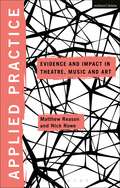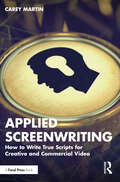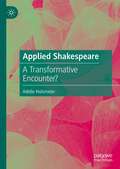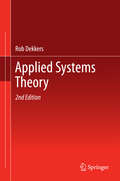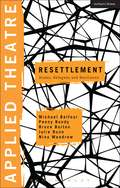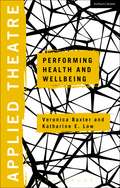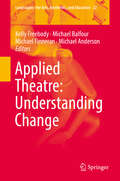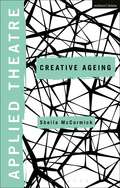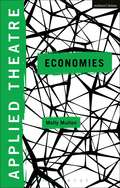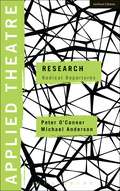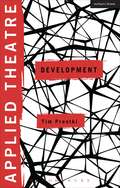- Table View
- List View
Applied Practice: Evidence and Impact in Theatre, Music and Art (Applied Theatre)
by Nick Rowe Matthew Reason Sheila Preston Michael BalfourApplied Practice: Evidence and Impact in Theatre, Music and Art engages with a diversity of contexts, locations and arts forms – including theatre, music and fine art – and brings together theoretical, political and practice-based perspectives on the question of 'evidence' in relation to participatory arts practice in social contexts. This collection is a unique contribution to the field, focusing on one of the vital concerns for a growing and developing set of arts and research practices. It asks us to consider evidence not only in terms of methodology but also in the light of the ideological, political and pragmatic implications of that methodology.In Part One, Matthew Reason and Nick Rowe reflect on evidence and impact in the participatory arts in relation to recurring conceptual and methodological motifs. These include issues of purpose and obliquity; the relationship between evidence and knowledge; intrinsic and instrumental impacts, and the value of participatory research. Part Two explores the diversity of perspectives, contexts and methodologies in examining what it is possible to know, say and evidence about the often complex and intimate impact of participatory arts. Part Three brings together case studies in which practitioners and practice-based researchers consider the frustrations, opportunities and successes they face in addressing the challenge to produce evidence for the impact of their practice.
Applied Practice: Evidence and Impact in Theatre, Music and Art (Applied Theatre)
by Nick Rowe Matthew Reason Sheila Preston Michael BalfourApplied Practice: Evidence and Impact in Theatre, Music and Art engages with a diversity of contexts, locations and arts forms – including theatre, music and fine art – and brings together theoretical, political and practice-based perspectives on the question of 'evidence' in relation to participatory arts practice in social contexts. This collection is a unique contribution to the field, focusing on one of the vital concerns for a growing and developing set of arts and research practices. It asks us to consider evidence not only in terms of methodology but also in the light of the ideological, political and pragmatic implications of that methodology.In Part One, Matthew Reason and Nick Rowe reflect on evidence and impact in the participatory arts in relation to recurring conceptual and methodological motifs. These include issues of purpose and obliquity; the relationship between evidence and knowledge; intrinsic and instrumental impacts, and the value of participatory research. Part Two explores the diversity of perspectives, contexts and methodologies in examining what it is possible to know, say and evidence about the often complex and intimate impact of participatory arts. Part Three brings together case studies in which practitioners and practice-based researchers consider the frustrations, opportunities and successes they face in addressing the challenge to produce evidence for the impact of their practice.
Applied Puppetry: The Theory and Practice of Object Ecologies
by Matt SmithDrawing on thirty years of making theatre with objects, this field-defining book maps the terrain of applied puppetry.Through a range of case studies both personal and practical, Matt Smith offers a reflective and engaging study which provides makers, thinkers and students alike with a toolkit for thinking about and making puppetry in community settings.Through eight chapters, Smith muses on the nature of creativity, explores approaches to puppetry through ecology, and considers how puppets and objects affect the act of making and – in turn – how they affect those who make, use and experience them in performance.Along the way, Applied Puppetry offers practical exercises in theatre-making, demonstrates the political power of puppetry beyond borders, and interrogates the limitations and possibilities of puppetry and object theatre in local communities, volatile contexts and difficult circumstances.
Applied Puppetry: The Theory and Practice of Object Ecologies
by Matt SmithDrawing on thirty years of making theatre with objects, this field-defining book maps the terrain of applied puppetry.Through a range of case studies both personal and practical, Matt Smith offers a reflective and engaging study which provides makers, thinkers and students alike with a toolkit for thinking about and making puppetry in community settings.Through eight chapters, Smith muses on the nature of creativity, explores approaches to puppetry through ecology, and considers how puppets and objects affect the act of making and – in turn – how they affect those who make, use and experience them in performance.Along the way, Applied Puppetry offers practical exercises in theatre-making, demonstrates the political power of puppetry beyond borders, and interrogates the limitations and possibilities of puppetry and object theatre in local communities, volatile contexts and difficult circumstances.
Applied Reconfigurable Computing. Architectures, Tools, and Applications: 14th International Symposium, ARC 2018, Santorini, Greece, May 2-4, 2018, Proceedings (Lecture Notes in Computer Science #10824)
by Nikolaos Voros Michael Huebner Georgios Keramidas Diana Goehringer Christos Antonopoulos Pedro C. DinizThis book constitutes the proceedings of the 14th International Conference on Applied Reconfigurable Computing, ARC 2018, held in Santorini, Greece, in May 2018. The 29 full papers and 22 short presented in this volume were carefully reviewed and selected from 78 submissions. In addition, the volume contains 9 contributions from research projects. The papers were organized in topical sections named: machine learning and neural networks; FPGA-based design and CGRA optimizations; applications and surveys; fault-tolerance, security and communication architectures; reconfigurable and adaptive architectures; design methods and fast prototyping; FPGA-based design and applications; and special session: research projects.
Applied Screenwriting: How to Write True Scripts for Creative and Commercial Video
by Carey MartinPutting a vision on the page for creative and commercial video is harder than it seems, but author Carey Martin explains how to bring these tools to bear in the “work for hire” environment. Whilst other texts focus on writing the next award winner, this can be out of reach both logistically and financially for many. Instead, readers will learn how to write what they want the eyes of the audience to see and the ears of the audience to hear, in such a way that the Producer and Director can read the creative blueprint and bring that vision to life. The text will walk readers through a focused and practical consideration of the camera, the edit, and the sound design, in addition to a straightforward application of basic story principles. By understanding writing for video as more than creating a recorded play, readers will become more effective screenwriters and, should they wish, Producers and Directors as well. This book is ideal for students of screenwriting and those writing scripts for message-driven video for corporate, nonprofit, and commercial production.
Applied Screenwriting: How to Write True Scripts for Creative and Commercial Video
by Carey MartinPutting a vision on the page for creative and commercial video is harder than it seems, but author Carey Martin explains how to bring these tools to bear in the “work for hire” environment. Whilst other texts focus on writing the next award winner, this can be out of reach both logistically and financially for many. Instead, readers will learn how to write what they want the eyes of the audience to see and the ears of the audience to hear, in such a way that the Producer and Director can read the creative blueprint and bring that vision to life. The text will walk readers through a focused and practical consideration of the camera, the edit, and the sound design, in addition to a straightforward application of basic story principles. By understanding writing for video as more than creating a recorded play, readers will become more effective screenwriters and, should they wish, Producers and Directors as well. This book is ideal for students of screenwriting and those writing scripts for message-driven video for corporate, nonprofit, and commercial production.
Applied Shakespeare: A Transformative Encounter?
by Adelle HulsmeierThis book speaks to those interested in where and why Shakespeare’s work is used to capture the transformative intentions of different areas of Applied Theatre practice (Prison, Disability, Therapy), representing a foundational study which considers subsequent histories and potential challenges when engaging with Shakespeare’s work. This is grounded in a case study analysis of three salient British Theatre Companies: The Education Shakespeare Company (prison), the Blue Apple Theatre Company (Disability), and the Combat Veteran Players (therapy).
Applied Structural and Mechanical Vibrations: Theory and Methods, Second Edition
by Paolo L. GattiThe second edition of Applied Structural and Mechanical Vibrations: Theory and Methods continues the first edition's dual focus on the mathematical theory and the practical aspects of engineering vibrations measurement and analysis. This book emphasises the physical concepts, brings together theory and practice, and includes a number of worked-out
Applied Systems Theory
by Rob DekkersOffering an up-to-date account of systems theories and its applications, this book provides a different way of resolving problems and addressing challenges in a swift and practical way, without losing overview and grip on the details. From this perspective, it offers a different way of thinking in order to incorporate different perspectives and to consider multiple aspects of any given problem. Drawing examples from a wide range of disciplines, it also presents worked cases to illustrate the principles. The multidisciplinary perspective and the formal approach to modelling of systems and processes of ‘Applied Systems Theory’ makes it suitable for managers, engineers, students, researchers, academics and professionals from a wide range of disciplines; they can use this ‘toolbox’ for describing, analysing and designing biological, engineering and organisational systems as well as getting a better understanding of societal problems. This revised, updated and expanded second edition includes coverage of abductive reasoning, the relevance of systems theories for research methods and a new chapter about problem analysis and solving based on systems theories.
Applied Systems Theory
by Rob DekkersOffering an up-to-date account of systems theories and its applications, this book provides a different way of resolving problems and addressing challenges in a swift and practical way, without losing overview and not having a grip on the details. From this perspective, it offers a different way of thinking in order to incorporate different perspectives and to consider multiple aspects of any given problem. Drawing examples from a wide range of disciplines, it also presents worked cases to illustrate the principles. The multidisciplinary perspective and the formal approach to modelling of systems and processes of ‘Applied Systems Theory’ makes it suitable for managers, engineers, students, researchers, academics and professionals from a wide range of disciplines; they can use this ‘toolbox’ for describing, analysing and designing biological, engineering and organisational systems as well as getting a better understanding of societal problems.
Applied Theatre: Drama, Refugees and Resilience (Applied Theatre)
by Michael Balfour Penny Bundy Bruce Burton Julie Dunn Nina WoodrowThe book offers a compelling combination of analyis and detailed description of aesthetic projects with young refugee arrivals in Australia. In it the authors present a framework that contextualises the intersections of refugee studies, resilience and trauma, and theatre and arts-based practice, setting out a context for understanding and valuing the complexity of drama in this growing area of applied theatre. Applied Theatre: Resettlement includes rich analysis of three aesthetic case studies in Primary, Secondary and Further Education contexts with young refugees. The case studies provide a unique insight into the different age specific needs of newly arrived young people. The authors detail how each group and educational context shaped diverse drama and aesthetic responses: the Primary school case study uses process drama as a method to enhance language acquisition and develop intercultural literacy; the Secondary school project focuses on Forum Theatre and peer teaching with young people as a means of enhancing language confidence and creating opportunities for cultural competency in the school community, and the further education case study explores work with unaccompanied minors and employs integrated multi art forms (poetry, art, drama, digital arts, clay sculptures and voice work) to increase confidence in language acquisition and explore different forms of expression and communication about the transition process. Through its careful framing of practice to speak to concerns of power, process, representation and ethics, the authors ensure the studies have an international relevance beyond their immediate context. Drama, Refugees and Resilience contributes to new professional knowledge building in the fields of applied theatre and refugee studies about the efficacy of drama practice in enhancing language acquisition, cultural settlement and pedagogy with newly arrived refugee young people.
Applied Theatre: Drama, Refugees and Resilience (Applied Theatre)
by Michael Balfour Penny Bundy Bruce Burton Julie Dunn Nina Woodrow Sheila PrestonThe book offers a compelling combination of analyis and detailed description of aesthetic projects with young refugee arrivals in Australia. In it the authors present a framework that contextualises the intersections of refugee studies, resilience and trauma, and theatre and arts-based practice, setting out a context for understanding and valuing the complexity of drama in this growing area of applied theatre. Applied Theatre: Resettlement includes rich analysis of three aesthetic case studies in Primary, Secondary and Further Education contexts with young refugees. The case studies provide a unique insight into the different age specific needs of newly arrived young people. The authors detail how each group and educational context shaped diverse drama and aesthetic responses: the Primary school case study uses process drama as a method to enhance language acquisition and develop intercultural literacy; the Secondary school project focuses on Forum Theatre and peer teaching with young people as a means of enhancing language confidence and creating opportunities for cultural competency in the school community, and the further education case study explores work with unaccompanied minors and employs integrated multi art forms (poetry, art, drama, digital arts, clay sculptures and voice work) to increase confidence in language acquisition and explore different forms of expression and communication about the transition process. Through its careful framing of practice to speak to concerns of power, process, representation and ethics, the authors ensure the studies have an international relevance beyond their immediate context. Drama, Refugees and Resilience contributes to new professional knowledge building in the fields of applied theatre and refugee studies about the efficacy of drama practice in enhancing language acquisition, cultural settlement and pedagogy with newly arrived refugee young people.
Applied Theatre: Performing Health and Wellbeing (Applied Theatre)
by Veronica Baxter Katharine E. Low Michael Balfour Sheila PrestonApplied Theatre: Performing Health and Wellbeing is the first volume in the field to address the role that theatre, drama and performance have in relation to promoting, developing and sustaining health and wellbeing in diverse communities. Challenging concepts and understanding of health, wellbeing and illness, it offers insight into different approaches to major health issues through applied performance. With a strong emphasis on the artistry involved in performance-based health responses, situated within a history of the field of practice, the volume is divided into two sections:Part One examines some of the key questions around research and practice in applied performance in health and wellbeing, specifically addressing the different regional challenges that dominate the provision of health care and influence wellbeing: how the ageing population of the global north creates pressure on lifetime healthcare provision, while the global south is dominated by a higher birth rate and a larger population under 15 years old. Part Two comprises case studies and interviews from international practitioners that reflect the diversity of practices across the world and in particular differences between work in the northern and southern hemispheres. These case studies include a sanitation project in a Hmong refugee camp in Thailand in the 1980s, and the sanitation and rural development projects initiated by the travelling theatre troupes of a number of University theatre departments in Africa – Makerere in Kampala, Uganda; Botswana; Lesotho and Dar es Salaam, Tanzania – which began in the 1960s. It considers the emergence of Theatre for Development's use as a health approach, considering the work of Laedza Batanani and the influences of Augusto Boal's Theatre of the Oppressed.
Applied Theatre: Performing Health and Wellbeing (Applied Theatre)
by Veronica Baxter Katharine E. Low Michael Balfour Sheila PrestonApplied Theatre: Performing Health and Wellbeing is the first volume in the field to address the role that theatre, drama and performance have in relation to promoting, developing and sustaining health and wellbeing in diverse communities. Challenging concepts and understanding of health, wellbeing and illness, it offers insight into different approaches to major health issues through applied performance. With a strong emphasis on the artistry involved in performance-based health responses, situated within a history of the field of practice, the volume is divided into two sections:Part One examines some of the key questions around research and practice in applied performance in health and wellbeing, specifically addressing the different regional challenges that dominate the provision of health care and influence wellbeing: how the ageing population of the global north creates pressure on lifetime healthcare provision, while the global south is dominated by a higher birth rate and a larger population under 15 years old. Part Two comprises case studies and interviews from international practitioners that reflect the diversity of practices across the world and in particular differences between work in the northern and southern hemispheres. These case studies include a sanitation project in a Hmong refugee camp in Thailand in the 1980s, and the sanitation and rural development projects initiated by the travelling theatre troupes of a number of University theatre departments in Africa – Makerere in Kampala, Uganda; Botswana; Lesotho and Dar es Salaam, Tanzania – which began in the 1960s. It considers the emergence of Theatre for Development's use as a health approach, considering the work of Laedza Batanani and the influences of Augusto Boal's Theatre of the Oppressed.
Applied Theatre: Understanding Change (Landscapes: the Arts, Aesthetics, and Education #22)
by Kelly Freebody Michael Balfour Michael Finneran Michael AndersonThis volume offers researchers and practitioners new perspectives on applied theatre work, exploring the relationship between applied theatre and its intent, success and value. Applied theatre is a well-established field focused on the social application of the arts in a range of contexts including schools, prisons, residential aged care and community settings. The increased uptake of applied theatre in these contexts requires increased analysis and understanding of indications of success and value. This volume provides critical commentary and questions regarding issues associated with developing, delivering and evaluating applied theatre programs. Part 1 of the volume presents a discussion of the ways the concept of change is presented to and by funding bodies, practitioners, participants, researchers and policy makers to discover and analyse the relationships between applied theatre practice, transformative intent, and evaluation. Part 2 of the volume offers perspectives from key authors in the field which extend and contextualize the discussion by examining key themes and practice-based examples.
Applied Theatre: The Key Concepts (Routledge Key Guides)
by Kay HepplewhiteThis accessible book outlines the key ideas that define the global phenomenon of applied theatre, not only its theoretical underpinning, its origins and practice, but also providing eight real-life examples drawn from a diversity of forms and settings.The clearly arranged topic sections entitled When, What, Who, Why and Where emphasise the responsive nature of applied theatre, its social context and the importance of a beneficial outcome for participants, which can connect fields as disparate as health, criminal justice, education and migration. Labels and terms are explained, along with applied theatre’s core values, motivations and objectives, allowing the reader to build a coherent understanding of its distinguishing features.Applied Theatre: The Key Concepts is aimed at students, academics, artists and practitioners of applied theatre as well as those with an interest in this vital blend of social and creative practice.
Applied Theatre: The Key Concepts (Routledge Key Guides)
by Kay HepplewhiteThis accessible book outlines the key ideas that define the global phenomenon of applied theatre, not only its theoretical underpinning, its origins and practice, but also providing eight real-life examples drawn from a diversity of forms and settings.The clearly arranged topic sections entitled When, What, Who, Why and Where emphasise the responsive nature of applied theatre, its social context and the importance of a beneficial outcome for participants, which can connect fields as disparate as health, criminal justice, education and migration. Labels and terms are explained, along with applied theatre’s core values, motivations and objectives, allowing the reader to build a coherent understanding of its distinguishing features.Applied Theatre: The Key Concepts is aimed at students, academics, artists and practitioners of applied theatre as well as those with an interest in this vital blend of social and creative practice.
Applied Theatre: Creative Ageing (Applied Theatre)
by Sheila McCormick Sheila Preston Michael BalfourApplied Theatre: Creative Ageing examines the complex social, political and cultural needs of a diverse group in our society and asks how contemporary applied theatre responds to those needs. It allows an examination of innovative national and international practice in applied theatre that responds to the needs of older adults to encourage outcomes such as wellbeing and social inclusion. The book does this while also questioning how we, as a society, wish to respond to the complex needs of older adults and the process of ageing and how applied theatre practices can help us do so in a way that is both positive and inclusive. In Part One Sheila McCormick reviews and historicises the practice of applied theatre with, for and by the elderly. It argues that pioneering applied theatre strategies are vital if the creative practice is to respond to the growing needs of older members of society, and reflects on particular cultural responses to ageing and the elderly.The second part of the book is made up of essays and case studies from leading experts and practitioners from Britain, America and Australia, including consideration of applied theatre approaches to dementia, health, wellbeing, social inclusion and Alzheimer's disease.
Applied Theatre: Creative Ageing (Applied Theatre)
by Sheila McCormick Sheila Preston Michael BalfourApplied Theatre: Creative Ageing examines the complex social, political and cultural needs of a diverse group in our society and asks how contemporary applied theatre responds to those needs. It allows an examination of innovative national and international practice in applied theatre that responds to the needs of older adults to encourage outcomes such as wellbeing and social inclusion. The book does this while also questioning how we, as a society, wish to respond to the complex needs of older adults and the process of ageing and how applied theatre practices can help us do so in a way that is both positive and inclusive. In Part One Sheila McCormick reviews and historicises the practice of applied theatre with, for and by the elderly. It argues that pioneering applied theatre strategies are vital if the creative practice is to respond to the growing needs of older members of society, and reflects on particular cultural responses to ageing and the elderly.The second part of the book is made up of essays and case studies from leading experts and practitioners from Britain, America and Australia, including consideration of applied theatre approaches to dementia, health, wellbeing, social inclusion and Alzheimer's disease.
Applied Theatre: Economies (Applied Theatre)
by Molly Mullen Michael Balfour Sheila PrestonThe APPLIED THEATRE series is a major innovation in applied theatre scholarship: each book presents new ways of seeing and critically reflecting on this dynamic and vibrant field. Volumes offer a theoretical framework and introductory survey of the field addressed, combined with a range of case studies illustrating and critically engaging with practice.Series Editors: Sheila Preston and Michael BalfourApplied Theatre: Economies addresses a notoriously problematic area: applied theatre's relationship to the economy and the ways in which socially committed theatre makers fund, finance or otherwise resource their work.Part One addresses longstanding concerns in the field about the effects of economic conditions and funding relationships on applied theatre practice. It considers how applied theatre's relationship with local and global economies can be understood from different theoretical and philosophical perspectives. It also examines a range of ways in which applied theatre can be resourced, identifying key issues and seeking possibilities for theatre makers to sustain their work without undermining their social and artistic values.The international case studies in Part Two give vivid insights into the day-to-day challenges of resourcing applied theatre work in Chile, Canada, the UK, New Zealand, Hong Kong and the US. The authors examine critical issues or points of tension that have arisen in a particular funding relationship or from specific economic activities. Each study also illuminates ways in which applied theatre makers can bring artistic and social justice principles to bear on financial and organizational processes.
Applied Theatre: Economies (Applied Theatre)
by Molly Mullen Michael Balfour Sheila PrestonThe APPLIED THEATRE series is a major innovation in applied theatre scholarship: each book presents new ways of seeing and critically reflecting on this dynamic and vibrant field. Volumes offer a theoretical framework and introductory survey of the field addressed, combined with a range of case studies illustrating and critically engaging with practice.Series Editors: Sheila Preston and Michael BalfourApplied Theatre: Economies addresses a notoriously problematic area: applied theatre's relationship to the economy and the ways in which socially committed theatre makers fund, finance or otherwise resource their work.Part One addresses longstanding concerns in the field about the effects of economic conditions and funding relationships on applied theatre practice. It considers how applied theatre's relationship with local and global economies can be understood from different theoretical and philosophical perspectives. It also examines a range of ways in which applied theatre can be resourced, identifying key issues and seeking possibilities for theatre makers to sustain their work without undermining their social and artistic values.The international case studies in Part Two give vivid insights into the day-to-day challenges of resourcing applied theatre work in Chile, Canada, the UK, New Zealand, Hong Kong and the US. The authors examine critical issues or points of tension that have arisen in a particular funding relationship or from specific economic activities. Each study also illuminates ways in which applied theatre makers can bring artistic and social justice principles to bear on financial and organizational processes.
Applied Theatre: Radical Departures (Applied Theatre)
by Peter O'Connor Michael AndersonApplied Theatre: Research is the first book to consolidate thinking about applied theatre as research through a thorough investigation of ATAR as a research methodology. It will be an indispensable resource for teachers and researchers in the area.The first section of the book details the history of the relationship between applied theatre and research, especially in the area of evaluation and impact assessment, and offering an examination of the literature surrounding applied theatre and research. The book then explores how applied theatre as research (ATAR) works as a democratic and pro-social adjunct to community based research and explains its complex relationship to arts informed inquiry, Indigenous research methods and other research epistemologies. The book provides a rationale for this approach focusing on its capacity for reciprocity within communities. The second part of the book provides a series of international case studies of effective practice which detail some of the key approaches in the method and based on work conducted in Australia, New Zealand, Singapore and the South Pacific. The case studies provide a range of cultural contexts for the playing out of various forms of ATAR, and a concluding chapter considers the tensions and the possibilities inherent in ATAR.This is a groundbreaking book for all researchers who are working with communities who require a method that moves beyond current research practice.
Applied Theatre: Radical Departures (Applied Theatre)
by Peter O'Connor Michael AndersonApplied Theatre: Research is the first book to consolidate thinking about applied theatre as research through a thorough investigation of ATAR as a research methodology. It will be an indispensable resource for teachers and researchers in the area.The first section of the book details the history of the relationship between applied theatre and research, especially in the area of evaluation and impact assessment, and offering an examination of the literature surrounding applied theatre and research. The book then explores how applied theatre as research (ATAR) works as a democratic and pro-social adjunct to community based research and explains its complex relationship to arts informed inquiry, Indigenous research methods and other research epistemologies. The book provides a rationale for this approach focusing on its capacity for reciprocity within communities. The second part of the book provides a series of international case studies of effective practice which detail some of the key approaches in the method and based on work conducted in Australia, New Zealand, Singapore and the South Pacific. The case studies provide a range of cultural contexts for the playing out of various forms of ATAR, and a concluding chapter considers the tensions and the possibilities inherent in ATAR.This is a groundbreaking book for all researchers who are working with communities who require a method that moves beyond current research practice.
Applied Theatre: Development (Applied Theatre)
by Tim Prentki Sheila Preston Michael BalfourAt once both guide book and provocation, this is an indispensable companion for students and practitioners of applied theatre. It addresses all key aspects: principles, origins, politics and aesthetics in a concise and accessible style designed to appeal both to those who have recently discovered this sub-discipline and to experienced practitioners and academics.Part 1 is divided into two chapters. The first introduces the sub-discipline of Theatre for Development, covering its origins, principles and history, and providing an overview of theatre for development in Western contexts as well as in Africa, Asia, the Indian Subcontinent and Latin America. The second focuses upon theoretical and philosophical issues confronting the discipline and its relationship to contemporary politics, as well as considering its future role.Part 2 consists of seven chapters contributed by leading figures and current practitioners from around the world and covering a diverse range of themes, methodologies and aesthetic approaches. One chapter offers a series of case studies concerned with sexual health education and HIV prevention, drawn from practitioners working in Vietnam, Papua New Guinea, Southern Africa, and China. Other chapters include studies of intercultural theatre in the Peruvian Amazon; a programme of applied theatre conducted in schools in Canterbury, New Zealand, following the 2010 earthquake; an attempt to reinvigorate a community theatre group in South Brazil; and an exchange between a Guatemalan arts collective and a Dutch youth theatre company, besides others.
